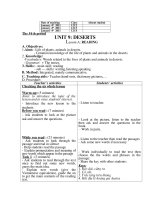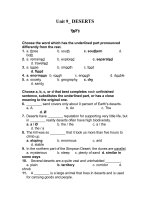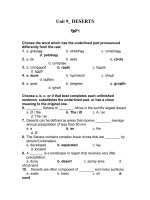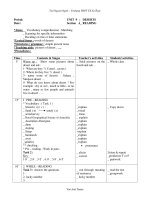Unit 9. Deserts
Bạn đang xem bản rút gọn của tài liệu. Xem và tải ngay bản đầy đủ của tài liệu tại đây (2.11 MB, 20 trang )
Find the animals hiding in the sentences.
1.That will be a real help.
bear
2.She came late everyday.
camel
3.He came to America today.
cat
4.If Roger comes, we’ll begin.
frog
5.In April, I only came once.
lion
6.I’ll sing, you hum on key.
monkey.
7.At last, I, Gerald had won
tiger
Work in pairs.
Ask and answer the following questions.
1. What do you know about deserts?
They are the large area of sand without trees and water,
but with severe climates, very hot during the day and
very cold at night. There is very little rainfall there; very
few people and animals except for in oases.
2. What kinds of plants and animals live in a desert?
Only camels, cacti and a kind of spinifex can live there.
3. Name some of the countries which have deserts?
Australia, Mongolia, the USA and North Africa
Task 1: Give the Vietnamese equivalents to the
following words or phrases.
1. Aerial survey:
2. Dune (n) :
5. Hummock (n) :
6. Sloping (adj) :
3. Stretch (n):
7. Steep (adj) :
4. Australian Aborigine :
8. Crest (n) :
9. Spinifex (n) :
10. Royal Geographical Society of Australia :
11. Sandy (adj) :
Task 1: Give the Vietnamese equivalents to the
following words or phrases.
1. Aerial survey: ['eəriəl] Cuộc khảo sát trên không
2. Dune (n) :
[dju:n] đụn cát
3. Stretch (n):
[stret∫] dải đất
4. Australian Aborigine :
thổ dân Úc
5. Hummock (n) : ['hʌmək] gò, đống
6. Sloping (adj) : [sləupin]dốc thoai thoải
7. Steep (adj) :
[sti:p dốc đứng
][krest] đỉnh
8. Crest (n) :
Task 1: Give the Vietnamese equivalents to the
following words or phrases.
9. Spinifex (n) : ['spainəfeks ] cỏ lá nhọn
10. Royal Geographical Society of Australia :
Hội địa lý hoàng gia Úc
11. Sandy (adj) : [ sandi] có nhiều cát
Task 2 : Decide whether the statements are
True (T) or False (F).
T
1.According to the passage, there are three great
deserts in Australia.
2. The Simpson Desert is the largest one in
Australia.
3. The desert was named after Simpson in 1929.
F
4. Colson and Madigan travelled across the
Simpson Desert in 1963
5. There are more dunes in the western part of
the desert.
6. Dry salt lakes are in the northern part or the
desert.
Task 3 : Answer the following questions
4.
Who
was
Simpson?
What
are
dunes
likeDesert
in
the
western
and
Lucky
number
Lucky
3.
When
did
the
European
enter
theSimpson
desert?
5.
How
did
E.first
A.
Colson
and
an
Australian
7.6.
How
many
kinds
ofnumber
grass
grow
in
the
2.
Where
is
the
Simpson
?
1 . Whatparts
are the
names
of the three great
northern
of
the
desert?
Aborigine
across the desert ?
Desert
? Whattravel
are they?
stretches
sandy
desert
thethe
He
wasbetween
theofPresident
ofEyre
thewhich
South
Australian
In
1845
It
lies
Lake
in thecircle
south,
centre
of
Australia?
In
the
western
part,
they
are
short,
mostly
Branch
of
the
Royal
Geographical
Society
of
Macdonnel
Ranges
in
the
north,
the
Mulligan
TheyThey
tookare
camels
acrossgrasses
the desert.
Two.
hummock
and spinifex.
less
than
10 meters high,
and
in
the
northern
part,
Australia
and
the
Diamantina
Rives
in
the
east,
and
the
They are Great Victoria Deserts , Gibbon, great
they are parallel and are up to 20 meters high.
Macumba
FinkeDesert
Riversand
in the
west. Desert
Sandy andand
Tanami
Simpson
Task 3. Answer the following questions
1. What are the names of the three great stretches of sandy desert which circle the
centre of Australia?
They are Great Victoria Deserts , Gibbon, great Sandy and Tanami Desert and Simpson
Desert
2. Where is the Simpson Desert ?
It lies between Lake Eyre in the south, the Macdonnel Ranges in the north, the Mulligan
and the Diamantina Rives in the east, and the Macumba and Finke Rivers in the west.
3. When did the first European enter the desert?
In 1845
4. Who was Simpson?
He was the President of the South Australian Branch of the Royal Geographical Society
of Australia
5. How did E. A. Colson and an Australian Aborigine travel across the desert ?
They took camels across the desert.
6. What are the dunes like in the western and northern parts of the desert?
In the western part, they are short, mostly less than 10 meters high, and in the northern
part, they are parallel and are up to 20 meters high.
7. How many kinds of grass grow in the Simpson Desert ? What are they?
Two. They are hummock grasses and spinifex
Read this story and answer
the questions that follow.
At a restaurant, a Vietnamese interpreter was having
dinner with an American businessman. It was a delicious
dinner and both of them enjoyed it enormously. Before
the dinner was over, the interpreter asked the American
businessman: “What would you like for your desert?”
After a pause, the American businessman answered:
“Trees and water”.
1. Is the story funny?
2. Where is the
fun? - desert /’dezət/ (n) sa mạc
- desert /di’zə:t/ (v) từ bỏ
- dessert /di’zə:t/ (n) món tráng miệng
• Prepare Speaking lesson
2. Dune (n) :
[dju:n]
đụn cát
4. Australian Aborigine
thổ dân Úc
5. Hummock (n) ['hʌmək]
gò, đống
6. Sloping (adj) [sləupin]
dốc thoai thoải
7. Steep (adj) [sti:p
dốc đứng ]
đỉnh
8. Crest (n) [krest
]
cỏ lá nhọn
9. Spinifex (n)
['spainəfeks ]









